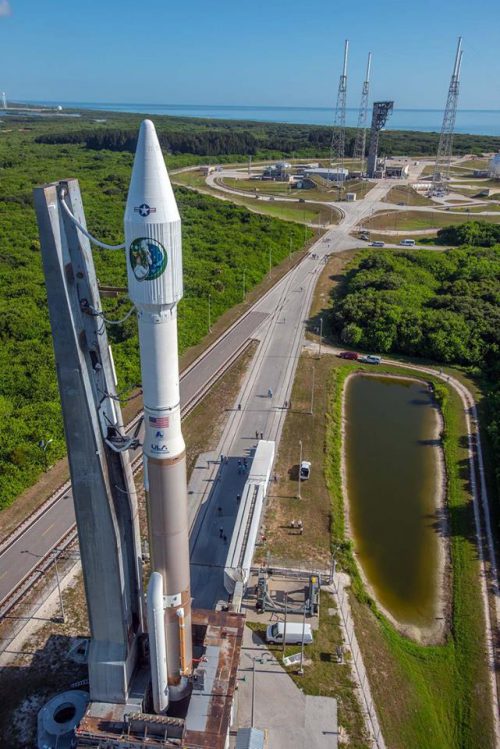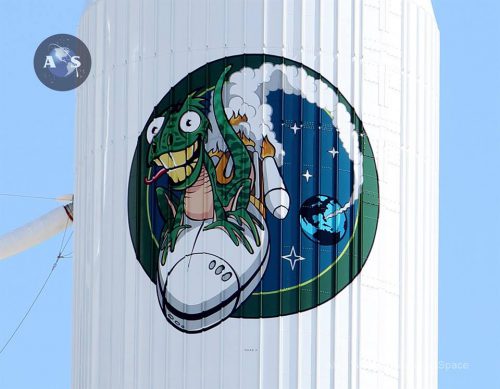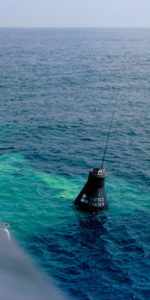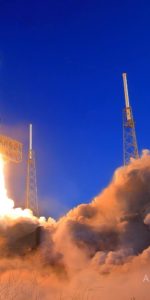
Two major military space and intelligence operations vital to U.S. national security and future combat operations are underway this week.
They are:
- National Reconnaissance Office NRO-61:

A detailed mathematical analysis indicates that the Top Secret National Reconnaissance Office NRO-61 spacecraft, set for launch from Cape Canaveral July 28 onboard a United Launch Alliance (ULA) Atlas-V 421 rocket, is the first of a new generation of larger, heavier geosynchronous orbit “Quasar” data relay satellites for real time transfer of imagery and other data from low earth digital imaging and other intelligence satellites.
On Tuesday July 26, the 200-foot-tall, 944,000-lb Atlas vehicle was rolled out on its rail-mounted Mobile Launcher Platform (MLP) from ULA’s Vertical Integration Facility 1,800 feet to Launch Complex 41.
Liftoff of the Atlas-V 421 with two solid rocket boosters is set for Thursday at 8:37 a.m. EDT, at the start of a launch window that extends to 9:34 a.m. EDT.
Follow our NROL-61 Launch Tracker for regular updates and LIVE COVERAGE on launch day!
- Navy MUOS 5 satcom trouble shooting progress:
In an unrelated, important military space development, AmericaSpace has also learned exclusively that the Navy/Lockheed Martin Mobile Objective User System MUOS-5 communications spacecraft has begun climbing, after earlier being stuck 12,000 miles below its intended geosynchronous orbit checkout location over the Pacific Ocean.
The problem, likely involving propulsion and possibly control as well, occurred when the 7-ton spacecraft was halfway up its planned nine-day transfer to geosynchronous orbit following launch from Cape Canaveral on an Atlas-V on June 24 (see AmericaSpace report June 25).
Navy spokesman Steve Davis at the Space and Naval Warfare Systems Command in San Diego said the Navy is not yet ready to release details on the problem.
Sources told AmericaSpace, however, that an initial maneuver this month was able to move the spacecraft 25 miles higher, brightening hopes that the $611 million satellite can be eventually elevated to geosynchronous orbit even if it has to inch its way up.
———————————————————————————————
The USAF 45th Space Wing’s Weather Squadron forecasts an 80 percent chance of “very favorable” weather expected for launch attempts on both July 28 and 29, should a backup day be needed. The Weather Squadron says the only weather issues could be the presence of cumulous clouds and/or an isolated rain shower.

The NRO 61’s novel mission patch features “Spike” riding on the Atlas V, with four stars honoring the government/industry team that developed the satellite and booster.
The flight’s 57-minute-long launch window should allow any coastal clouds or showers to clear within the window.
The Quasar analysis, performed by Canadian space analyst Ted Molczan and his global “SeeSat L” satellite observation partners, indicate NRO-61’s design “may be optimized to support the next generation heavy electro-optical imagery intelligence satellites of KH-11 lineage,” he tells AmericaSpace.
The first two of these extremely advanced multispectral “exquisite imaging” block-5 electro optical satellites with 2-inch resolution are planned for liftoff in 2018 and 2020.
NRO-61 would mark the fourth block change in the critical relay satellite program since the first Hughes Satellite Data System (SDS) spacecraft was launched in 1975 to relay imagery from the first Lockheed KH-11 digital imaging reconnaissance spacecraft launched in 1976.
The flight marks the first NRO mission using the Atlas-V 421 version with two solid rocket boosters and a single engine.
The spacecraft weighs up to 11,000 lbs and will be placed into a geosynchronous transfer orbit, with parameters forecasted by Molczan and his team to be 35,743 km x 844 km (22,210 mi x 531 mi).
A larger and heavier design is indicated by use of the Atlas-V 421 version, which the NRO has never used before the NRO-61 flight.
Previous NRO Satellite Data System spacecraft used the Atlas-V 401 version with no solid rocket motors and smaller shrouds. The flight marks only the sixth time that any user has flown on the 421 version, according to ULA.
After liftoff on 1.62 million-lb thrust, the Atlas-V vehicle is to fly eastward on a 99 degree azimuth as part of a classified ascent profile.
At roughly 4 minutes, 10 seconds into the ascent the Energomash RD-180 first stage engine is to shut down and initiate separation of the first stage at about 77-mile altitude at 9,000 mph.
The mission will then begin a three burn profile with the 25,000-lb thrust Centaur upper stage. Those maneuvers will involve:
- First Centaur burn is calculated to start 4 minutes, 26 seconds into the flight, with cutoff calculated to place the upper stage and payload into about a 186 km x 834 km (115 mi x 518 mi) orbit to coast across the Atlantic Ocean.
- Fairing jettison is to occur at about 4 minutes, 35 seconds.
- Second Centaur burn cutoff is calculated to place the upper stage and payload into a 35,743 km x 844 km (22,210 mi x 531 mi) geosynchronous transfer orbit.
The upper stage and spacecraft will then coast together for a short period before the satellite is separated from the Centaur.

The NRO-61 spacecraft will then begin to use its own propulsion system to gradually raise perigee to 22,210 miles, then maneuver in the equatorial arc to its planned geosynchronous orbit checkout location before maneuvering again to its classified operational parking orbit position.
Third Centaur burn is calculated to place the upper stage minus the satellite into a 28,104 km x -53 km (17,453 mi by -33 mi) subsurface perigee to dive the Centaur into the Pacific ocean about 750 km (465 miles) south of Hawaii at about 8 hours, 22 minutes, following liftoff from the Cape.
The NRO-61 flight will mark the 53rd Atlas-V to be launched out of Cape Canaveral since 2002, and the fourth in 2016. Eleven additional Atlas-Vs have been launched from Vandenberg AFB, Calif., since the rocket first debuted.
To be cautious and thorough, Molczan notes that his relay satellite analysis is solid and supported by SeeSat team members, but that he “cannot rule out the possibility” that the payload is a new geosynchronous orbit signals intelligence SIGINT satellite instead of an advanced relay.
But he doubts it.
This is because a new model of geosynchronous orbit SIGINT spacecraft [NRO 67] was already launched in April 2014 on an Atlas-V 541 and, “it seems unlikely” for two new SIGINT models to be introduced so close together in time (see AmericaSpace report April 10, 2014 NRO-67 story).
.
Be sure to “Like” AmericaSpace on Facebook and follow us on Twitter: @AmericaSpace
.
Missions » MUOS » MUOS-5 » Missions » NROL » NROL-61 »





2 Comments
2 Pings & Trackbacks
Pingback:Successful NRO/ULA NRO-61 Launch Bolsters Secret Relay « AmericaSpace
Pingback:AFSPC-6 Launch Helps Form Extraordinary New U.S. Space Defense Foundation « AmericaSpace